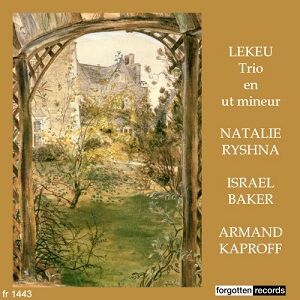
Guillaume Lekeu (1870-1894)
Piano Trio in C minor (1891)
Natalie Ryshna (piano)
Israel Baker (violin)
Armand Kaproff (cello)
rec. 1958, Contemporary Records studio, Los Angeles
FORGOTTEN RECORDS FR1443 [44]
The ill-fated composer Guillaume Lekeu lived a brief yet fascinatingly fecund life in the time he was allotted, with some fifty compositions to his credit. He certainly left his mark on Belgian classical music. He was one of a group of Belgian composers that included such esteemed names as César Franck, Henri Vieuxtemps and Eugène Ysaÿe. He was born in Heusy, a village near Verviers. In 1879, aged nine, he moved with his parents to Poitiers in France. In June 1888, his family relocated to Paris. After some initial studies, Lekeu became a pupil of César Franck, but when the composer died in 1890 he continued with Vincent d’Indy. In October 1893 he contracted typhoid fever and passed away at his parents’ home in Angers on 21 January 1894, the day after his 24th birthday. At the time of his death he had begun to show much promise as a young composer.
The Piano Trio in C minor is an ambitious score, cast in four substantial movements. It occupied Lekeu from 1889-1891. It wasn’t published, however, until after his death in 1908. The young composer’s adept mastery and compositional resource are very much in evidence. Despite influences of Franck and Beethoven, Lekeu was very much his own man, with the melodic writing and harmonic adventure stamped with his own seal. Despite Lekeu’s initial reservations about the work’s length, these were subsequently dispelled. The Trio is packed tight with passion and surging lyricism; it’s a highly emotional work.
A slow, ominous and darkly-etched Lent intro sets the scene for a passionate and animated Allegro. Lekeu’s contrapuntal skill is strikingly showcased. A slow movement follows, marked Très lent. It’s richly expressive and imbued with sincerity and tenderness. The Scherzo is approached with brilliance of attack and tensile strength. It has a grief-laden central section. The finale is structured in arch-form Lent-Animé-Lent. The opening is very Beethovenian, ushering in a more confident Animé. There’s plentiful lyrical dialogue between the instruments. The work ends in dreamy and hazy fashion, almost dying away to nothingness.
The recording derives from a Society for Forgotten Music LP (SFM 1004) and was set down in Los Angeles in July 1958. It stands up well for its age. The pianist and cellist are new names to me. The violinist, Israel Baker, I was already familiar with through his chamber music collaborations with violinist Jascha Heifetz and cellist Gregor Piatigorsky. The performance is heartfelt and fervent, with a real sense of epic sweep. The three instrumentalists are finely balanced in the mix.
Stephen Greenbank
| Availability |  |


















